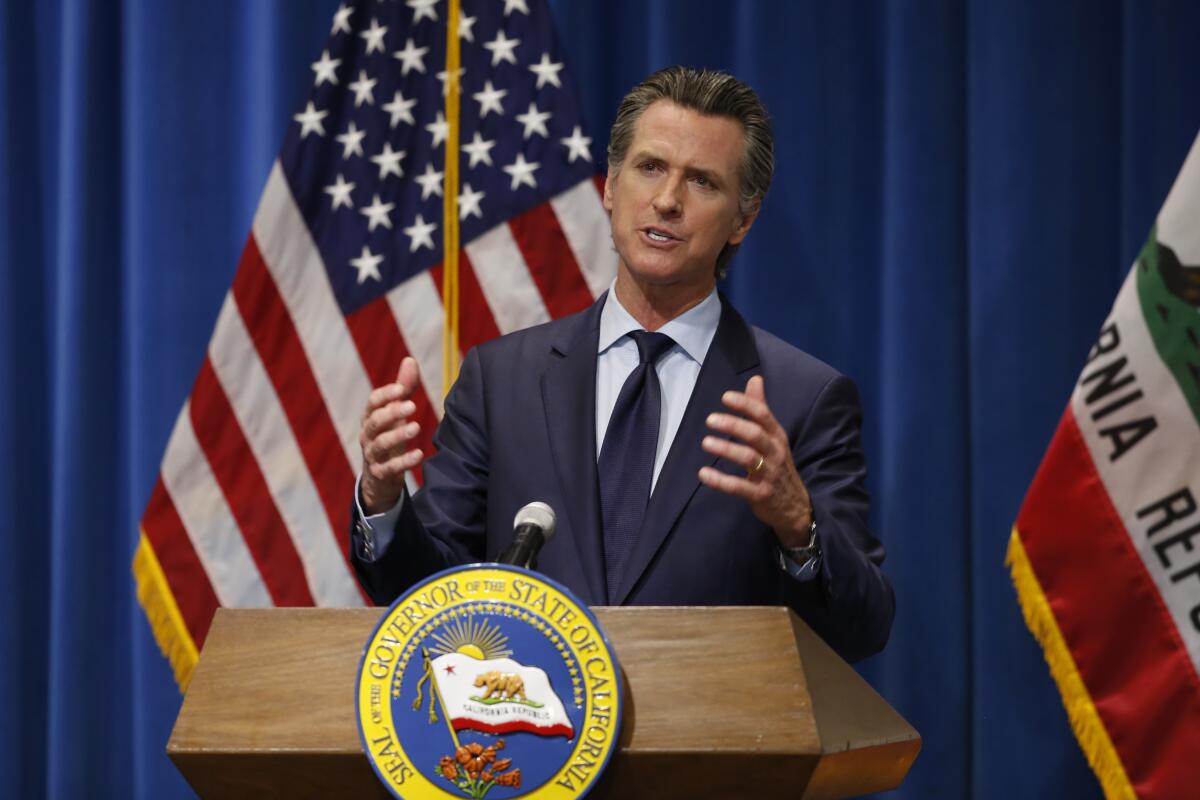Op-Ed: It’s not too late to stop California’s recall election

With just weeks before the California recall election on Sept. 14, time is running out for a lawsuit to be brought to challenge the recall procedure. But it is not too late. Voters need to quickly bring a lawsuit, ideally directly in the California Supreme Court, where justices could declare unconstitutional the method of choosing a successor if the governor is recalled.
Article II, Section 15 of the California Constitution provides the procedure for the recall election. It says that if “the majority vote on the question is to recall, the officer is removed and, if there is a candidate, the candidate who receives a plurality is the successor.”
Opinion polls show that the vote is likely to be close on whether to recall Gov. Gavin Newsom and that if he is recalled, none of the candidates is likely to get more than 20% of the vote. The result is a virtual certainty that if Newsom is recalled, he will get far more votes — probably more than twice as many — as whoever would replace him. There easily could be a situation in which 49% of the voters want Newsom to remain, but because he is recalled, a successor who garnered less than 20% of the votes would replace him.
This makes no sense and violates the most basic notions of democracy. Far more people want Newsom to be governor than want any of the 46 candidates on the ballot to replace him. The U.S. Supreme Court long has held that equal protection requires that every voter get an equal say in determining the results of an election. Under California’s recall system, the votes of those who choose the new governor are given two or three times the weight of the votes of those who wanted Newsom to remain in office. This violates the long-established constitutional principle of “one person, one vote.”
The recall ballot accomplishes in two steps what would be patently unconstitutional and unacceptable in one. Weighting votes of Newsom opponents more than his supporters would never be constitutional in a single ballot question in which all candidates were pitted against each other. And the U.S. Supreme Court has made clear that if an election process is unconstitutionally skewed, it cannot simply be restructured to accomplish the same result.
Some might disagree with this analysis by saying that it is two different elections, one on whether to recall Newsom and the other on who should succeed him, and that it is inappropriate to compare the vote totals. This ignores that it is one ballot, and the reality is that in this election, the candidate preferred by the most voters could well lose to one favored by far fewer. It also ignores the fact that the arguments against Newsom do not allege wrongful disqualifying conduct but rather amount to political disagreements and questions about whom voters favor as governor.
Although the case can be brought in federal court, it likely would be better at this stage to file it directly in the California Supreme Court. There are many reasons for this. California law is much more permissive than federal law in terms of who has standing to sue, the ability to bring a case to court. Any California voter ought to be able to bring this suit in a California court, because all of the state’s voters are affected by the unconstitutional process.
State courts are also a better route because the U.S. Supreme Court repeatedly has stressed, including just a year ago, that federal courts should not get involved in election processes just before the vote. No such principle exists in the California courts.
Finally, at this late date, the state needs a quick, definitive resolution, which the California Supreme Court could provide. Any lawsuit in federal court would inevitably entail appeals, which would be difficult to complete before the recall election.
Even though the lawsuit would be based on the U.S. Constitution, the California Supreme Court has jurisdiction to hear it and could provide necessary relief. State courts always have the authority to decide federal law claims. At this stage, the easiest solution is for the California Supreme Court to allow the recall election to go forward but hold that if Newsom is recalled, the lieutenant governor will then become governor until the expiration of Newsom’s term in January 2023. This is not radical, because in all other situations, the lieutenant governor takes over when the governor leaves office before the end of a term.
Why hasn’t anyone filed this suit yet? Perhaps it reflects that people are slow to realize that there is a real chance that Newsom will be recalled and one of the 46 on the ballot could replace him. Or maybe the thought is that it would be better to wait and bring the challenge if Newsom is recalled. But that is a dangerous gamble because a court probably will be more reluctant to invalidate the results of the election after it occurs.
The far preferable solution is to resolve this now and for the California Supreme Court to hold that the procedures specified by the California Constitution violate the equal protection clause of the 14th Amendment to the U.S. Constitution. We should not risk allowing a candidate preferred by a small minority of Californians to be the next governor.
Erwin Chemerinsky is dean of the UC Berkeley School of Law and a contributing writer to Opinion. Aaron Edlin is a professor of law and economics at UC Berkeley.
More to Read
A cure for the common opinion
Get thought-provoking perspectives with our weekly newsletter.
You may occasionally receive promotional content from the Los Angeles Times.









